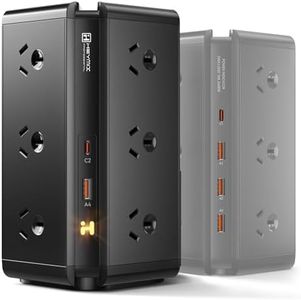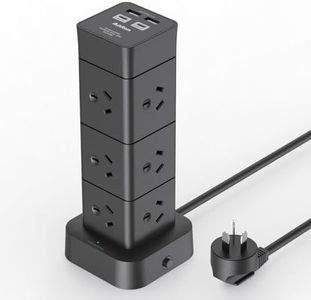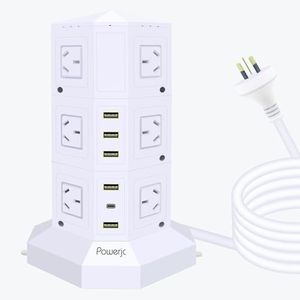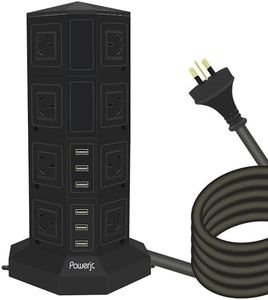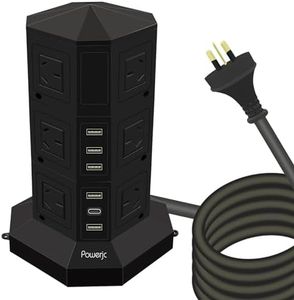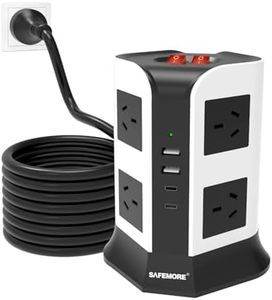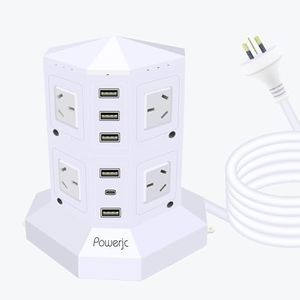We Use CookiesWe use cookies to enhance the security, performance,
functionality and for analytical and promotional activities. By continuing to browse this site you
are agreeing to our privacy policy
10 Best Power Strip Tower
From leading brands and best sellers available on the web.Buying Guide for the Best Power Strip Tower
Choosing the right power strip tower can make your daily charging and power management a lot more convenient, especially if you have multiple devices or limited access to wall outlets. When selecting a power strip tower, you’re looking for a device that provides safety, capacity, and easy access to power for your gadgets. Understanding a few key features will help you pick a model that fits your needs and keeps your devices safe and organized.Number of OutletsThe number of outlets tells you how many devices you can plug in at once. This is important because too few outlets can leave you searching for additional spots to charge, while too many can tempt you to overload the strip. Most towers range from 8 to 16 outlets. Smaller towers (8-10 outlets) fit best for a personal desk, bedside, or small living spaces, while larger towers (12-16 outlets) are great for families or shared workspaces with many devices. Count up what you regularly need to plug in, including things like phone chargers, laptops, lamps, and select a tower with a couple of extra outlets for flexibility.
USB PortsUSB ports are for charging phones, tablets, and other USB-powered devices without the need for a separate adapter. Towers typically have between 2 and 6 USB ports. If you often charge multiple USB devices at once, choose a model with more USB ports. Check if the USB ports are standard or feature fast-charging technology; fast charging is useful if you need to quickly juice up devices like smartphones or tablets. Think about your regular charging habits and match the number and capability of USB ports accordingly.
Surge ProtectionSurge protection safeguards your connected devices from electrical spikes or surges, which can occasionally occur with unstable electricity. This is important for protecting sensitive electronics. Power strip towers are rated for joules, indicating how much energy they can absorb from a surge before losing effectiveness. Typical ranges are from 500 to 2000 joules. Lower ratings suit lamp or basic device setups, while higher ratings are better if you're plugging in expensive electronics like computers or TVs. Pick a surge protection level based on the value and sensitivity of what you’ll be connecting.
Cord LengthThe cord length determines how far your tower can be from the wall outlet. Shorter cords (3-5 feet) work well if the power source is nearby and you want less clutter. Medium cords (6-8 feet) offer more flexibility for typical room setups, while longer cords (10 feet or more) are ideal if you need to place the tower far from a wall outlet, such as in a home office away from the walls. Measure the distance from your nearest wall outlet to where you want the tower to sit so you can select the right cord length.
Tower Design and SizeThe design and size affect both how much space the tower takes up and how accessible the outlets are. Slim or compact models are best if you want something for a desk or nightstand, while larger towers with more spacing between outlets are easier for plugging in bulkier adapters. Look for a tower with a stable base and enough room between outlets for your specific plugs and chargers.
Switches and Individual ControlSome towers come with master or individual switches that let you turn off the whole strip or just certain sections without unplugging devices. This can save energy and add convenience. If you tend to leave devices plugged in for long periods or want to control power supply to specific gadgets, consider a tower with these features.
Safety CertificationsSafety certifications, such as UL or ETL listing, mean the product has been tested for safe operation standards. This is especially important for a device that will handle multiple electronics at once. Always look for such certifications to make sure you and your devices are protected, especially in homes with children or pets.
